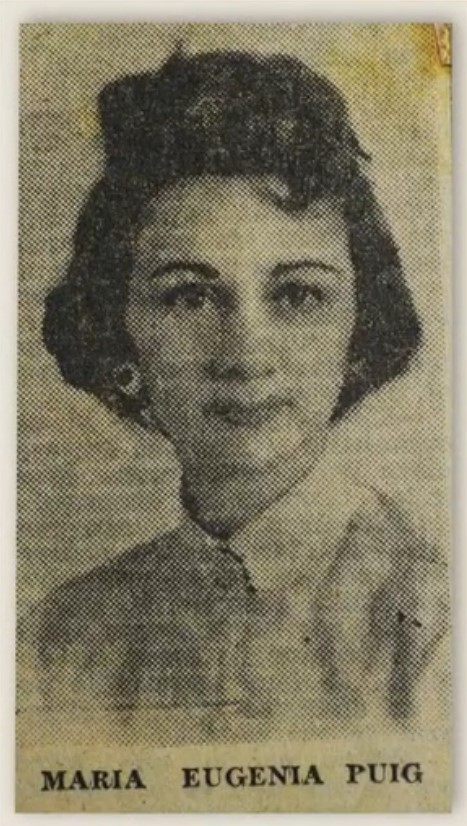María Eugenia Puig Lince (Guayaquil, August 2, 1919 – Quito, February 4, 2001) was an Ecuadorian poet, intellectual, and diplomat. She co-founded the Grupo Cultural “Oasis” in 1955 alongside Rosa Borja de Ycaza and Zoila Luisa Campodónico de Caputti, and served as its director, documenting the group’s activities in the magazine “Oasis.” She was also a key figure in founding the Pan-American Women’s Round Table of Ecuador, advocating for women’s cultural involvement. Her legacy is honored through the Museo Municipal de Arte “María Eugenia Puig Lince,” inaugurated in Guayaquil in 2013.
Early Life and Family
María Eugenia Puig Lince was born on August 2, 1919, in Guayaquil, Ecuador. She was the daughter of Eduardo Arturo Puig Arosemena and Mercedes Germania Lince Sotomayor y Luna. She had a sister, Beatriz Puig Lince, and two half-siblings, Jorge Eduardo Puig Rubio and Pilar Puig Rubio. María Eugenia later became the mother of three children, including Juan Falconí Puig, a prominent Ecuadorian lawyer, diplomat, and politician, who served as Ecuador’s Ambassador to the United Kingdom in 2013 and as Permanent Representative to the World Trade Organization in 2015.
Literary and Cultural Career
Puig made significant contributions to Ecuadorian literature and culture as a poet and intellectual. Her work primarily involved poetry, and she was involved in the Ecuadorian literary community throughout her life. She co-founded the Grupo Cultural “Oasis” on June 5, 1955, along with Rosa Borja de Ycaza and Zoila Luisa Campodónico de Caputti. She also served as the director of the group, and their work was documented in the magazine “Oasis”.
In addition to her literary work, Puig was involved in diplomacy and women’s cultural organizations. She was one of the founders of the Pan-American Women’s Round Table of Ecuador, an organization aimed at fostering women’s participation in cultural and intellectual discourse across the Americas.
She was featured in the 2011 anthology “Cantos a Guayaquil” and the 2005 anthology “Mujeres frente al espejo”, which highlighted the work of prominent Ecuadorian women poets.
Personal Life and Death
María Eugenia Puig Lince passed away on February 4, 2001, in Quito, Ecuador, at the age of 81. Honoring her wishes, her ashes were scattered in the Guayas River, the river that witnessed her birth, fulfilling her final desire: “Mis cenizas al río que me vio nacer” (“My ashes to the river that saw me born”).
Legacy
In recognition of her contributions to Ecuadorian culture, the Museo Municipal de Arte “María Eugenia Puig” was inaugurated in Guayaquil on November 15, 2013. The museum is a significant cultural institution, dedicated to exploring Ecuadorian history through art and preserving the country’s heritage.
Poem
SIMÓN BOLÍVAR, EL LIBERTADOR
I
Bolívar es un dios de sangre y cal
que en corcel se adentró por llano y sierra
Bolívar es un dios sobre la tierra
abatiendo los ámbitos del mal.
Bolívar es un dios de sangre y cal.
Es el egregio genio de la guerra.
Cuando un pueblo decae, cuando yerra,
Bolívar vuelve en forma inmaterial.
Bolívar por la roca y por la greda
olvidado de sí, en su pegasó,
liberta las naciones en su vuelo.
Bolívar, es la fuerza que nos queda
cuando el tirano, con aleve paso,
arrebatarnos quiere, nuestro suelo.
II
Bolívar es la América bravía.
El sol augusto que en Oriente empieza.
Bolívar, es la América que reza
ante la gloria de su bizarría.
Venezuela se ufana en nombradía.
Con cimera de inmortal cabeza
que desechó corona y su realeza
en la ventura de un hermoso día.
Fusión del mito y realidad humana
en Bolívar, ya tiene su presencia.
Se ciñe de laureles su memoria.
Ante la ola de la mente insana,
Bolívar viergue su señera esencia.
Bolívar, es la Patria. Y es la Historia!
III
Bolívar se inspiró en el Aventino
y al Chimborazo su delirio ofrece.
La Condamine, a su pie, aparece.
Ha vencido el abismo, con su sino.
Tribuno, Presidente, es el destino.
Héroe que al mundo sin igual se ofrece.
Y es Colombia que luego enorgullece.
—En su seno San Pedro Alejandrino.
La sangre y cal se aquietan. Y la idea
que al proteico fustiga en reciedumbre,
el arrojo guerrero y el ingenio?
De nuestra América es emblema y tea;
Liberta de tutela y servidumbre.
De América, Bolívar, es el genio!
MARÍA EUGENIA PUIG
Guayaquil, Julio 24 de 1.974.
Published in EL TELÉGRAFO - Guayaquil
Miércoles 24 de Julio de 1974
Originally published in El Telégrafo (Guayaquil), Wednesday, July 24, 1974.
Selected Works
- Alma en azur (1949)
- Cantos de amor (1957)
- Ámbito (1963)
- Sonetos de la angustia (1969)
- Cuando el amor habla (1986)
References
- Geni.com, “María Eugenia Puig Lince.” Retrieved on October 21, 2024. Click to view.
- Buen Trip, “Museo Municipal de Arte ‘María Eugenia Puig Lince’.” Retrieved on October 21, 2024. Click to view.
- Google Books, “Cuando el amor habla.” Retrieved on October 21, 2024. Click to view.
- Homenaje a Maria Eugenia Puig Lince, “Museo Municipal de Arte ‘María Eugenia Puig Lince’ Video.” Retrieved on October 21, 2024. Click to view.
- X.com, “Eduardo Franco Loor on María Eugenia Puig Lince.” Retrieved on October 21, 2024. Click to view.
- Hotel Malecon Inn Blog, “Museo Municipal de Arte María Eugenia Puig.” Retrieved on October 21, 2024. Click to view.
- IQLatino.org, “Ecuador moldea su historia en arcilla – Galería.” Retrieved on October 21, 2024. Click to view.
- Universidad Andina Simón Bolívar, “Mujeres frente al espejo.” Retrieved on October 21, 2024. Click to view.
- Wikibrief.org, “Juan Falconí Puig.” Retrieved on October 21, 2024. Click to view.

